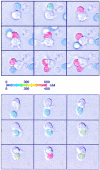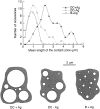Antigen-dependent and -independent Ca2+ responses triggered in T cells by dendritic cells compared with B cells
- PMID: 9782124
- PMCID: PMC2213410
- DOI: 10.1084/jem.188.8.1473
Antigen-dependent and -independent Ca2+ responses triggered in T cells by dendritic cells compared with B cells
Abstract
Dendritic cells (DCs) are much more potent antigen (Ag)-presenting cells than resting B cells for the activation of naive T cells. The mechanisms underlying this difference have been analyzed under conditions where ex vivo DCs or B cells presented known numbers of specific Ag-major histocompatibility complex (MHC) complexes to naive CD4(+) T cells from T cell antigen receptor (TCR) transgenic mice. Several hundred Ag-MHC complexes presented by B cells were necessary to elicit the formation of a few T-B conjugates with small contact zones, and the resulting individual T cell Ca2+ responses were all-or-none. In contrast, Ag-specific T cell Ca2+ responses can be triggered by DCs bearing an average of 30 Ag-MHC complexes per cell. Formation of T-DC conjugates is Ag-independent, but in the presence of the Ag, the surface of the contact zone increases and so does the amplitude of the T cell Ca2+ responses. These results suggest that Ag is better recognized by T cells on DCs essentially because T-DC adhesion precedes Ag recognition, whereas T-B adhesion requires Ag recognition. Surprisingly, we also recorded small Ca2+ responses in T cells interacting with unpulsed DCs. Using DCs purified from MHC class II knockout mice, we provide evidence that this signal is mostly due to MHC-TCR interactions. Such an Ag-independent, MHC-triggered calcium response could be a survival signal that DCs but not B cells are able to deliver to naive T cells.
Figures










Similar articles
-
B lymphocytes in vivo fail to prime naive T cells but can stimulate antigen-experienced T lymphocytes.J Exp Med. 1993 Mar 1;177(3):679-90. doi: 10.1084/jem.177.3.679. J Exp Med. 1993. PMID: 8436906 Free PMC article.
-
Dendritic type, accessory cells within the mammalian thymic microenvironment. Antigen presentation in the dendritic neuro-endocrine-immune cellular network.In Vivo. 1997 Jul-Aug;11(4):351-70. In Vivo. 1997. PMID: 9292303
-
Antibody-mediated targeting of antigen to C-type lectin-like receptors Clec9A and Clec12A elicits different vaccination outcomes.Mol Immunol. 2017 Jan;81:143-150. doi: 10.1016/j.molimm.2016.12.010. Epub 2016 Dec 12. Mol Immunol. 2017. PMID: 27978488
-
Processing and presentation of idiotypes to MHC-restricted T cells.Int Rev Immunol. 1993;10(4):337-55. doi: 10.3109/08830189309061709. Int Rev Immunol. 1993. PMID: 8294847 Review.
-
The binding of antigen presenting cells to T lymphocytes.Adv Exp Med Biol. 1988;237:31-41. doi: 10.1007/978-1-4684-5535-9_4. Adv Exp Med Biol. 1988. PMID: 3075854 Review.
Cited by
-
Human dendritic cells are superior to B cells at presenting a major histocompatibility complex class II-restricted heterologous antigen expressed on recombinant Streptococcus gordonii.Infect Immun. 2000 Apr;68(4):1879-83. doi: 10.1128/IAI.68.4.1879-1883.2000. Infect Immun. 2000. PMID: 10722577 Free PMC article.
-
Mapping the sensitivity of T cells with an optical trap: polarity and minimal number of receptors for Ca(2+) signaling.Proc Natl Acad Sci U S A. 1999 Jul 20;96(15):8471-6. doi: 10.1073/pnas.96.15.8471. Proc Natl Acad Sci U S A. 1999. PMID: 10411899 Free PMC article.
-
Dangerous liaisons at the virological synapse.J Clin Invest. 2004 Sep;114(5):605-10. doi: 10.1172/JCI22812. J Clin Invest. 2004. PMID: 15343375 Free PMC article. Review.
-
Imaging T-cell antigen recognition and comparing immunological and neuronal synapses.Immunology. 2001 Aug;103(4):417-25. doi: 10.1046/j.1365-2567.2001.01268.x. Immunology. 2001. PMID: 11529931 Free PMC article. Review. No abstract available.
-
Modeling T cell antigen discrimination based on feedback control of digital ERK responses.PLoS Biol. 2005 Nov;3(11):e356. doi: 10.1371/journal.pbio.0030356. Epub 2005 Oct 25. PLoS Biol. 2005. PMID: 16231973 Free PMC article.
References
-
- Steinman RM. The dendritic cell system and its role in immunogenicity. Annu Rev Immunol. 1991;9:271–296. - PubMed
Publication types
MeSH terms
Substances
LinkOut - more resources
Full Text Sources
Research Materials
Miscellaneous

